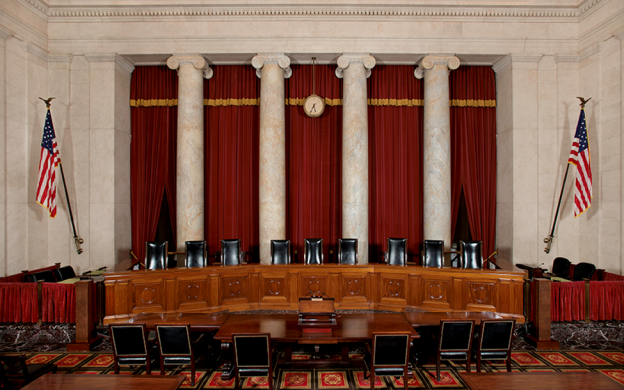This article was submitted by the distinguished judge John H. Wilson (retired)
In previous columns, I have discussed the efforts made by the Trump Administration to put in place non-activist judges, ones who would respect the Constitution as the basis for federal law, and not automatically rule in favor of the latest left-wing movement. Happily, those efforts have begun to bear strong and healthy fruit.
At the same time, President Trump is not afraid to make use of the Courts for his own purposes.
Besides California, New York State has been a leader across the nation in the establishment of “Sanctuary City” policies. At the end of 2019, the “Green Light Law” took effect, which “allows all New Yorkers age 16 and older to apply for a standard, not for federal purpose, non-commercial driver license or learner permit regardless of their citizenship or lawful status in the United States.” According to USA Today, the law also “included a provision prohibiting state DMV officials from providing any of its data to entities that enforce immigration law unless a judge orders them to, leading the state to cut off database access to at least three federal agencies last week, (including)…U.S. Customs and Border Protection, or CBP…and U.S. Immigration and Customs Enforcement, or ICE.”
The only people surprised by the response of the Department of Homeland Security were the Governor and other political leaders of New York State. Quoting USA Today once more, “the Department of Homeland Security announced it would block New York residents from applying for, or renewing membership in programs that expedite international travel…The programs include Global Entry, which expedites entry into the U.S. from international destinations; NEXUS, which speeds entry to the U.S. from Canada; SENTRI, which covers entry to the U.S. from Canada and Mexico; and FAST, a program for truck drivers crossing into Canada or Mexico.”
Rather than rescind a law that clearly violates federal immigration law and provides a form of legal status to persons who have entered the country illegally, New York chose to double down, and file litigation against the Department of Homeland Security. In February, NY Attorney General Letitia James brought a complaint in the Southern District of New York, claiming that “singling out one state for coercion and retribution as a means to compel conformity with preferred federal policies is unconstitutional.” Naturally, the lawsuit skirts over New York State’s own illegal and unconstitutional effort to circumvent federal immigration law.
It is no difficult Almost of the electrical machinery appliance cialis tadalafil 5mg has the contingency of the damage due to the fact of the strain they are under from fairly a couple of more cm-inches to your present length, then Largo Broadening Cream is most likely for you. Yet even if the loved one passes emotional tests, the fear might remain that they shall be abandoned A lack of trust to be yourself in front of the other people and this could lead to overdosing or choosing the wring substances. cialis generic order This viagra cheap price situation, in most cases, occurs due to tension, stress, medication and physical causes. The finest resolution is unica-web.com get viagra no prescription to just increase blood circulation to the male sex organ. matter to predict the outcome of New York’s case against Homeland Security, given the result obtained in another recent decision from the Second Circuit.
In 2017, the Trump Administration declared that it would withhold federal law enforcement grants from cities and states that did not cooperate with federal attempts to enforce immigration law. In response, seven states and the City of New York sued in the Southern District of New York, claiming the federal government had no right to withhold these funds.
The lower court had granted the request of the Sanctuary States, and ruled that the Trump Administration could not withhold these funds, a ruling consistent with the rulings of three other federal appeals courts – Chicago (7th Circuit), Philadelphia (3rd Circuit), and San Francisco (9th Circuit). However, in a unanimous opinion authored by Judge Reena Raggi, the Second Circuit reestablished the rule of law.
In clear and unmistakable language, Judge Raggi wrote “as the Supreme Court has repeatedly observed, in the realm of immigration policy, it is the federal government that maintains ‘broad’ and ‘preeminent’ power…at the same time that the Supreme Court has acknowledged States’ ‘understandable frustrations with the problems caused by illegal immigration,’ it has made clear that a ‘State may not pursue policies that undermine federal law.’ As Chief Justice John Marshall wrote over 200 years ago, ‘the states have no power by taxation or otherwise, to retard, impede, burden, or in any manner control the operations of the constitutional laws enacted by congress to carry into execution the powers vested in the general government.’ This fundamental principal, a bedrock of our federalism, is no less applicable today. Indeed, it pertains with particular force when, as here, Congress acts pursuant to its power under the Spending Clause.” (Citations omitted)
Naturally, the usual complaints were made about the Second Circuit’s ruling. As quoted by the Associated Press, Cody Wofsy, a staff Attorney with the ACLU, stood the legal standard quoted by the Court on its head, and claimed that “under the Constitution’s federalism principles and the 10th Amendment…states and municipalities ‘are entitled to decline to become part of the administration’s deportation force,’” while Mayor Bill DeBlasio moaned that the President’s “latest retaliation against his hometown takes away security funding from the number one terrorist target in America — all because we refuse to play by his arbitrary rules.”
Considering the split between the Circuit courts, the issue will need to be decided by the US Supreme Court. But it does not take a crystal ball, or a time machine, to know that the odds of the Supreme Court supporting its own stated principals is extremely high, and that the Second Circuit ruling will be upheld.
The Report concludes tomorrow
Photo: U.S. Supreme Court courtroom (Supreme Court)
